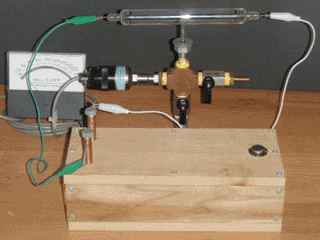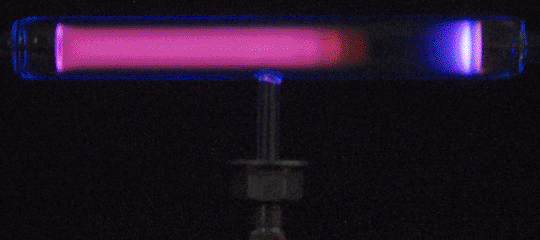

My first Geissler tube has been very useful as a vacuum gauge, due to its insensitivity to ambient temperature and the presence of distinct visual transitions at various levels of vacuum. However, it has a 5mm stem which is incompatible with the 1/4 inch adapter I currently use for vacuum tubes, and the ring-shaped electrodes are less than ideal for observing glow discharge. To solve both of these problems, I made a second Geissler tube with improved characteristics in all regards.

Other than the size of the tubing used, the primary difference in the construction of this new tube is the electrode assembly, which can be seen above. The electrodes themselves were turned from 304 stainless steel, and to provide stiff contacts for alligator clips I used a 1/16 inch TIG electrode for the feedthroughs. Tungsten of this diameter cannot be sealed directly into Pyrex (Corning 7740), so I fused a bead of uranium glass (Corning 3320) onto the tungsten beforehand to form a graded seal. Making the beads was very easy, but they ended up quite large (approximately 1/4 inch in diameter) so after sealing them into the Pyrex flare, the completed assemblies were annealed by wrapping them in Kaowool and letting them cool slowly to avoid cracking. Other than that, the rest of the glasswork was ordinary. The completed device (shown below) contains two 0.570 inch disc electrodes, five inches apart, inside a tube with an inner diameter of 0.625 inches. Some sputtering of the negative electrode can be seen, as this picture was taken after the tube had been used for roughly 30 minutes.

The tube performs very well, and the disc-shaped electrodes produce a much cleaner glow than the washers used in the previous tube. The Pyrex also fluoresces differently than the soda-lime glass used in the last tube, resulting in more visual "landmarks" in the millitorr range. The video below shows the tube being evacuated from atmospheric pressure to approximately 50 millitorr, while being powered by my spark box with the gap set to 1cm. Below 50 millitorr the glow does not change significantly, other than becoming dimmer overall as the air becomes less conductive. Below 20 millitorr the glow disappears completely and the spark gap begins firing, indicating that the breakdown voltage inside the tube is greater than 10KV.